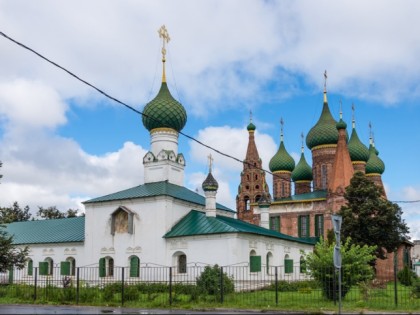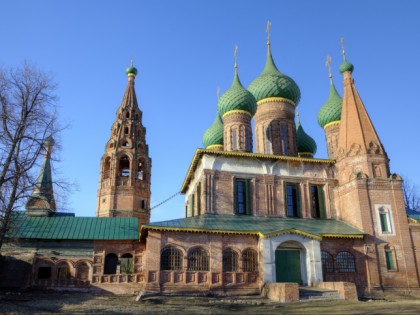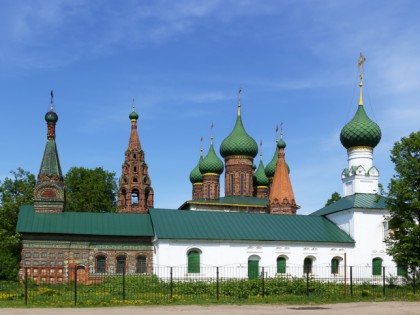Churches of St. Nicholas the Wet and the Tikhvin Icon of the Mother of God
The Churches of St. Nicholas the Wet (Church of Nikola Mokryi) and the Tikhvin Icon of the Mother of God, which are built less than 20 years apart, form an ensemble, although they differ from each other. The Church of the Tikhvin Icon of the Mother of God is modest and inconspicuous, while the Church of St. Nicholas the Wet, in spite of the desolation, is known for its preserved frescoes. Especially popular is the "forbidden" fresco: St. Christopher, depicted with a dog's head, is a combination inconceivable for an Orthodox church.
The Church of St. Nicholas the Wet was built in 1672 on a squashy ground, on the low bank of the Kotorosl River. It is believed that this is exactly what gave a name to the church. It is a five-domed temple, begirt with one-story galleries on three sides and a tent-shaped bell tower. Since this is an unheated summer church, an inconspicuous one-domed warm Church of the Tikhvin Icon of the Mother of God was built next to it 14 years later. Porches with octagonal tents, decorated with colored tiles, were added to the facades of both churches in the late 17th century. The painting of the Church of St. Nicholas the Wet contained about 660 topics! Not all of the frescoes have survived to this day, but the most vivid ones can still be seen. In addition to the image of St. Christopher, depicted in an unusual way, noteworthy here is a large-scale picture of the Last Judgment, scenes from the life and miracles of Nicholas the Wonderworker and scenes from the Old Testament. Moreover, the mural with the Last Judgment is not only allowed but also recommended to be touched: the infernal flame depicted on it is very cold at any time of the year.
GPS coordinates
57.62018046570005, 39.870758056640625
Phone
+7 485 2304277
Official website
Opening Hours
Now - closed
Mon-Fri
07:00-18:00
Sat-Sun
09:00-17:00
Nearby

Restoran "Russkaya oхota"

ThreeBeans Coffee
Coffee shop • Patisserie
+7 4852 336090
Payment methods:

Akademiya
Pizzeria
+7 4852 731450
Payment methods:

Sem pyatnic
Karaoke • Bar
+7 4852 906644

Sk Royal
Restaurant • Banquet room • Hotel • Bar
+7 4852 672921
Payment methods:

Burgernaya 838
Bistro • Café
+7 920 1048383
Payment methods:

Dzhuzeppe
Restaurant • Banquet room • Café • Pizzeria • Catering
+7 4852 663232
Payment methods:

5 avenyu
Night Club • Café
+7 4852 731551
Payment methods:

Kofetun Sushitun
Restaurant • Sushi bar • Café
+7 4852 675555
Payment methods:

Postfood
Café
+7 4852 335885
Payment methods:

Monument of Yaroslav the Wise
Architectural Monuments • Other places

Spaso-Preobrazhensky Monastery
Architectural Monuments • Temples and places of worship • Abbeys and Monasteries • Other places

Kraft i Burger
Fast Food • Bar
+7 4852 338304
Payment methods:

ProKofej
Banquet room • Café
+7 4852 305007
Payment methods:

Baget, pashtet i zheltyj pled
Café • Catering
+7 4852 932200
Payment methods:

PAPA Roma
Family restaurant
+7 4852 934244
Payment methods:

XLEB
Bar • Lounge • Bakery
+7 4852 594777

Mama Mia Bambini
Family restaurant • Café • Pizzeria
+7 4852 727882
Payment methods:

Kotorosl Embankment
Other places

Yubilejnaya
Restaurant • Banquet room • Hotel • Bar
+7 4852 592335
Payment methods:

Coffee Time
Banquet room • Café
+7 4852 947777
Payment methods:

Russkaya oхota
Restaurant • Banquet room
+7 4852 459700

Salat
Banquet room • Sushi bar • Café
+7 965 7263424
Payment methods:

Svoi da Nashi
Restaurant • Brewery • Disco
+7 4852 726272
Payment methods:

Prego
Restaurant • Banquet room
+7 4852 206120
Payment methods:

Grafin
Restaurant • Karaoke • Bar
+7 4852 339193

Chajхona sintab
Restaurant • Hookah bar
+7 4852 594299
Payment methods:

Rocky Pizza
Bar • Café • Pizzeria • Catering
+7 4852 288008
Payment methods:

Kavkazskaya plennica
Restaurant • Banquet room • Café
+7 4852 728006
Payment methods:

Bulanzhe
Coffee shop • Patisserie
+7 4852 330153
Payment methods:

The Residence of Her Majesty the Queen of Maslenitsa
Museums and Exhibitions • Other places

Xinkali-Xaus
Restaurant • Banquet room • Café • Catering
+7 4852 339458
Payment methods:

KOVChEG
Restaurant • Disco • Banquet room
+7 4852 648879

Utro
Coffee shop
+7 910 9765477
Payment methods:


